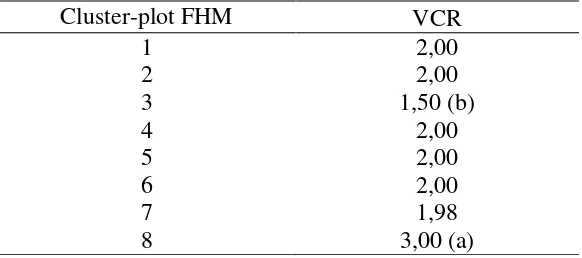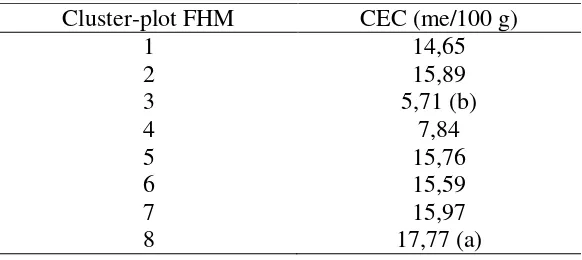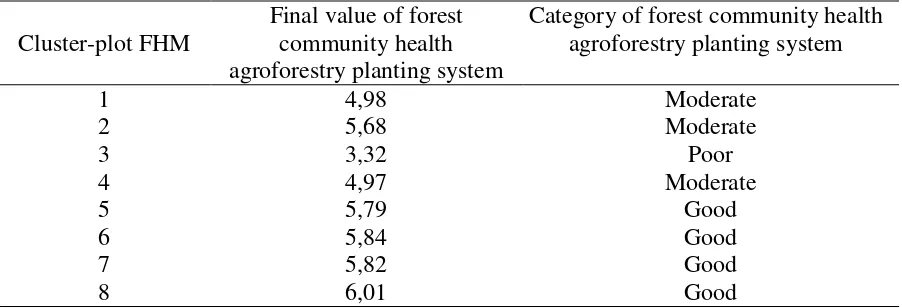HEALTH STATUS OF COMMUNITY FORESTS PLANTING THROUGH
AGROFORESTRY SYSTEM IN LAMPUNG PROVINCE1)
Rahmat Safe’i2
, Irwan Sukri Banuwa3, Christine Wulandari4, Hari Kaskoyo5, and Ruchyansyah6
1)
Paper presentation at Second Agroforestry International Congress, Vietnam, 27 – 29 November 2016 2,5)
Forestry Department, the University of Lampung, Email: [email protected] 3,4) Graduate Program of Forestry, the University of Lampung
6)
Forestry Office of Lampung Province (Dinas Kehutanan Provinsi Lampung), Graduate Student of Forestry Magister Program the University of Lampung
ABSTRACT
The health condition of forest ecosystems will be very important in the world, when global issues, such as climate change, air pollution, acid rain, forest fires, the quality and quantity of water, and the increase in human population has affected to sustainable forest management. Therefore, valid data and reliable information about the health condition of community forests planting by agroforestry system absolutely be necessary to obtain the right decision towards sustainable forest management. Forest health study conducted in February 2013 at 3 sub districts i.e. Pringsewu, Pesawaran, and Tanggamus. Objective of this study is analyzing status of community forest health that planted by agroforestry system. The case study of analyzes of forest health status was assessing through 8 cluster-plots (32 plot units) of Forest Health Monitoring (FHM) tools. Parameters of community forest health namely agroforestry planting system are tree growth, tree damage, crown condition, and soil fertility. The research results showed that the status of community forest health planting by agroforestry system in Lampung is mostly good (score 5,79 – 7,07) due to 4 cluster-plots has proven that forests on good condition. Then agroforestry planting system is recommend to be implemented in all community forests in Lampung province.
Key words: forest health, community forests, agroforestry planting system
INTRODUCTION
Forests for agroforestry planting systems are community forests that combine forestry crops with plantations, agriculture, food, livestock, and others. Kusumedi and Jariyah (2010) stated that community forests with agroforestry planting system provide short-term community income and long-term income as savings. In addition, community forests with agroforestry planting system have significant ecological impacts (Mahendra 2009), such as: clean air, controlled erosion, carbon uptake, water regulation, ecosystem buffers, ecological stability guards, and environmental protection (Darusman 2002). Therefore, in the management of community forests, the present and future agroforestry planting system must be able to pay attention to environmental principles. To achieve this, the forest of the people agroforestry planting system must be healthy.
especially in Lampung Province, awareness about the importance of forest health in achieving community forest management sustainable agroforestry planting system is still lacking, so forest health issues have not received serious attention (Permadi et al., 2012). Therefore, reliable data and information on the state of health status of forests of the people of agroforestry is absolutely required by the community forest managers agroforestry planting system to obtain the right decision for the implementation of community forest management system agroforestry planting system that supports the principles of sustainability. This study aims to obtain the health status of community forests of agroforestry planting system in Lampung Province.
METHODS
The location of the research on cluster-plots Forest Health Monitoring (FHM) for community forest agroforestry planting system in Pringsewu, Pesawaran, and Tanggamus Lampung Province. Number of cluster-plot FHM made by eight cluster-plot (32 plot). This research was conducted in February 2013.
Stages of the study consisted of determination of plot FHM establishment in community forest agroforestry planting system, plot FHM establishment, community forest health agroforestry planting system measures, and community forest health agroforestry planting system assessment techniques.
1. Determination of FHM plot establishment to conduct the evaluation and monitoring of bio-physical condition of community forest agroforestry planting system. Determination of plot FHM establishment is based forest management prescriptions. Prescription of forest management in the determination of FHM plot establishment is age classes (1, 2, 3, and 4 year) and planting distance (2 m x 2 m and 2 m x 3 m).
2. Measuring community forest health agroforestry planting system based method FHM. Community forest health agroforestry planting system measures ecological indicators by Supriyanto et al. (2001), those are: production (tree growth), biodiversity (species diversity), vitality (damage and crown conditions) and site quality (KTK), as follows: a. Tree Growth; Tree growth measurements performed on trees that were in the subplot.
prioritized according to location on the tree in the following order: roots, root and lower bole, lower bole, lower and upper bole, upper bole, crown stem, branches, buds and shoots, and foliage in FHM method; the measurement parameters are then collected in a damage index; damage index calculated in two different levels, as follows at tree level (TLI) and plot level (PLI). Crown condition in the FHM method measured the following parameters (Nuhamara and Kasno 2001): Live Crown Ratio (LCR), Crown density (Cden), Foliage Transparency (FT), Crown diameter (Crown
Diameter Width dan Crown Diameter at 900), and Crown Dieback (CDB);
measurement of the parameters of the fifth crown are collected into the Visual Crown Rating (VCR).
c. Site quality; Measurement of site quality is focused on soil fertility (KTK). Soil sampling will be located 3 (three) points between 2 (two) subplot with each circle diameter 15 cm. Sampling point of soil will be on the mineral surface layer, with a depth of 0-10 cm.
3. Community forest health agroforestry planting system assessment techniques. Community forest health agroforestry planting system assessment obtained from the final value (NA) of forest health conditions, which is the result of multiplying the weighted value and value score parameters of indicators on production (growth tree), vitality (damage and crown conditions) and site quality (KTK).
RESULTS AND DISCUSSION
Results
Measuring Community Forest Health
Based on the measurement of tree growth, tree damage condition, crown condition, and soil fertility with FHM method on eight clusters of FHM plots of community forest of agroforestry planting system, LBDS, CLI, VCR, and CEC. The values of LBDS, CLI, VCR, and CEC in each cluster FHM plots of community forest of agroforestry planting system are as follows:
Table 1. Value LBDS in cluster-plot FHM community forest Agroforestry planting system
Cluster-plot FHM LBDS (m2/ha)
1 3,35
2 3,06 (b)
3 3,47
4 4,93
5 9,62
6 8,72
7 13,77
8 18,96 (a)
Value CLI in cluster-plots FHM of community forest agroforestry planting system are presented in Table 2. The highest CLI value is 5.44 (a) and the lowest is 1.51 (b).
Table 2. Value CLI in cluster-plot FHM community forest Agroforestry planting system
Cluster-plot FHM CLI
1 2,43
2 2,25
3 5,44 (a)
4 1,82
5 3,37
6 1,96
7 1,78
8 1,51 (b)
Value VCR in cluster-plots FHM of community forest agroforestry planting system are presented in Table 3. The highest VCR value is 3.00 (a) and the lowest is 1.50 (b).
Table 3. Value VCR in cluster-plot FHM community forest Agroforestry planting system
Cluster-plot FHM VCR
1 2,00
2 2,00
3 1,50 (b)
4 2,00
5 2,00
6 2,00
7 1,98
8 3,00 (a)
Table 4. Values CEC in cluster-plot FHM community forest Agroforestry planting system
Cluster-plot FHM CEC (me/100 g)
1 14,65
2 15,89
3 5,71 (b)
4 7,84
5 15,76
6 15,59
7 15,97
8 17,77 (a)
Source: Analysis result of Balittan Laboratory, 2013
Community Forest Health Assessment Weighted Value and Score Value
The weighted value of ecological indicator parameters of community forest health agroforestry planting system using ANP techniques, namely: tree growth (0.30), damage conditions of trees (0.23), crown condition (0.23), and soil fertility (0.24) ). The scores of ecological indicator parameters of community forest health agroforestry planting system on each of the FHM clusters of community forest agroforestry planting system are presented in Table 5 below.
Table 5. Value score on cluster-plot FHM community forest Agroforestry planting system
Cluster-plot FHM LBDS CLI VCR CEC
1 1 8 4 8
2 1 7 4 10
3 1 1 1 3
4 5 9 4 2
5 4 9 4 9
6 4 10 4 9
7 6 9 4 9
8 9 9 4 9
Final Value of Community Forest Health
Value Threshold of community forest health agroforestry planting system methods are obtained based on the highest and lowest values of the final value of community forest health
Table 1. Treshold value of community foresthealth agroforestry planting system
Final value class
Community forest health
agroforestry planting system
category
5,79-7,07 Good
4,52-5,78 Moderate
3,24-4,51 Poor
Category of forest community health agroforestry planting system consists of 3 (three) categories, namely: good, moderat, and poor. Category of community forest health agroforestry planting system based on threshold value or final value class of community forest health agroforestry planting system. Category of forest community health agroforestry planting system is presented in Table 7 below.
Tabel 2 Final value and category forest community health agroforestry planting system Cluster-plot FHM
Final value of forest community health agroforestry planting system
Category of forest community health agroforestry planting system
1 4,98 Moderate
2 5,68 Moderate
3 3,32 Poor
4 4,97 Moderate
5 5,79 Good
6 5,84 Good
7 5,82 Good
8 6,01 Good
DISCUSSION
Table 7 shows that most categories of community forest health agroforestry planting system are in good condition. Value status of community forest agroforestry planting system is good (60%), moderator (30%), and poor (10%).
planting system can increase production and income (Diniyati et al., 2004) and regional economies (Irawanti et al., 2012).
There are several indicators as to why the forests of agroforestry planting systems have a good forest health status of 60%, among others are increased tree growth, small tree damage, healthy crown condition, and high soil fertility. The health condition of the community forest in the agroforestry planting system in FHM clusters is supported by the increase of LBDS, small CLI values, high VCR values, and large CEC value. The increase in LBDS shows the high productivity of trees. Small CLI values indicate that low levels of tree damage due to pest attack. VCR values are high enough to impact the capture of sunlight needed by the process of photosynthesis. The photosynthesis process will work well under good crown conditions (Agrios 1996) which will ultimately support optimal tree growth. A large CEC value can indicate that the soil is capable of trapping and providing better nutrients and is able to retain nutrients. Therefore, the action / management decision that must still be done by the community forest managers agroforestry planting system so that the health condition of the community forest agroforestry planting system remains healthy is to keep the trees of the stands must remain healthy by conducting regular fertilization activities, pest control disease, And crop maintenance, as tree damage will affect tree growth rates and crown conditions.
fact that there are many types of damage to tree plants that cause poor tree plant growth, such as open wounds. Types of damage are found in the lower stem area with a severity> 40%. The type of open wound damage to tree crops will result in disruption of the nutrient and water translocation process resulting in an imbalance of nutrient and water supply for the parts of the tree above. Criteria for soil fertility in community forests low agroforestry planting system. The indication is that the value of CEC in the community forest agroforestry planting system in the three plots is 5.71 me / 100 g which is low. Low soil fertility indicates that soil nutrients are low so that they affect plant growth and production.
CONCLUSION
The results showed status of community forests health of agroforestry planting system in Lampung Province was good (5.79-7.07) of 60%, thus indicating that community forest with agroforestry planting system will result in healthy community health forest level. Thus, the development of community forests in Lampung Province is directed by agroforestry planting system.
REFERENCES
Andayani. 2003. Strategi peningkatan efisiensi usaha perhutanan rakyat. J Hutan Rakyat 5(1): 17–29.
Agrios GN. 1996. Ilmu Penyakit Tumbuhan. Volume ke-3. Busnia M, penerjemah. Yogyakarta (ID): UGM Pr. Terjemahan dari: Plant Pathology.
Cline SP. 1995. FHM: Environmental Monitoring and Assessment Program. Washington D.C. (US): U.S. Environmental Protection Agency, Office of Research and Development.
Darusman D. 2002. Hutan Rakyat: Pengembangan Strategi Kehutanan. Di Dalam:
Pembenahan Kehutanan Indonesia. Bogor (ID): Laboratorium Politik Ekonomi dan
Sosial Kehutanan, Fakultas Kehutanan IPB bekerjasama dengan Yayasan Dani Hanifah.
Davis LS, Johnson KN. 1987. Forest Management.Third edition. New York (US): Mc Graw Hill Book Company, Inc.
Diniyati D, Yuliani SE, Suryano, Badrunasar A. 2004. Pola tanam hutan rakyat di jawa dalam rangka meningkatkan pendapatan petani. Al-Basia 1(4):1-14.
Hardjowigeno S. 1993. Klasifikasi Tanah dan Pedogenesis. Jakarta (ID): Akademika Pressindo.
Irawanti S. Suka AP. Ekawati S. 2012. Manfaat ekonomi dan peluang pengembangan hutan rakyat sengon di Kabupaten Pati. J Penelitian Sosial dan Ekonomi Kehutanan 9(3): 126–139.
Kusumedi P, Jariyah NA. 2010. Analisis finansial pengelolaan agroforestri dengan pola sengon kapulaga di Desa Tirip. Kecamatan Wadaslintang. Kabupaten Wonosobo.
Jurnal Penelitian Sosial dan Ekonomi Kehutanan 7(2): 93–100.
Mahendra F. 2009. Sistem Agroforstri dan Aplikasinya. Cetakan Pertama. Yogyakarta: Graha Ilmu.
Mangold R. 1997. Forest Health Monitoring: Field Methods Guide. USA (US): USDA Forest Service.
Nuhamara ST, Kasno. 2001. Present Status of Crown Indicators. Di dalam: Forest Health
Monitoring to Monitor The Sustainability of Indonesian Tropical Rain Forest. Volume
I. Japan (JP): ITTO dan Bogor (ID): SEAMEO-BIOTROP.
Permadi P, Lelana NE, Anggraeni I, Darwiati W. 2012. Rumusan Seminar. Didalam: Seminar Nasional Kesehatan Hutan dan Kesehatan Pengusahaan Hutan untuk Produktivitas
Hutan; 14 Juni 2012; Bogor, Indonesia. Bogor (ID): Pusat Litbang Peningkatan
Produksi Hutan. hlm 1-2.
Rusdiana O, Lubis RS. 2012. Pendugaan korelasi antara karakteristik tanah terhadap cadangan karbon pada hutan sekunder. JSilvikultur Tropika 3(1):14-21.
Saaty TL. 1996. The Analytic Hieararchy Process: Planning, Priority Setting, Resource
Allocation. Pittsburgh (US): RWS Publications.
Saaty TL. 2003. Decision-Making with the AHP: Why is The Proncipal Eigenvector
Necessary. European Journal of Operational Research 145(2003):85-91.
Saaty TL. 2005. Theory and Applications of the Analytic Network Process. Pittsburgh (US): RWS Publications.
Safe’i R, Hardjanto, Supriyanto, dan Sundawati L. 2015. Pengembangan Metode Penilaian Kesehatan Hutan Rakyat Sengon( (Miq.) Barneby & J.W. Grimes). J Penelitian Hutan Tanaman 12 (3): 175-187.
Sudiana E, Hanani N, Yanuwiadi B, Soemarno. 2009. Pengelolaan hutan rakyat berkelanjutan di Kabupaten Ciamis. Agritek 17(3): 543–555.
Sudomo A, Permadi P, Rachman E. 2007. Kajian kontrol silvikultur hutan tanaman terhadap kualitas kayu pulp. Info Teknis 5(2):1-10.
Supriyanto, Stolte KW, Soekotjo, Gintings AN. 2001. Forest Health Monitoring Plot Establishment. Di dalam: Forest Health Monitoring to Monitor The Sustainability of
Indonesian Tropical Rain Forest. Volume I. Japan (JP): ITTO dan Bogor (ID):
SEAMEO-BIOTROP.
[USDA-FS] United States Development Agency-Forest Service. 1999. Forest Health
Monitoring: Field Methods Guide (International 1999). Asheville NC (US): USDA


